Scuba diving gear: Everything to know about the equipment
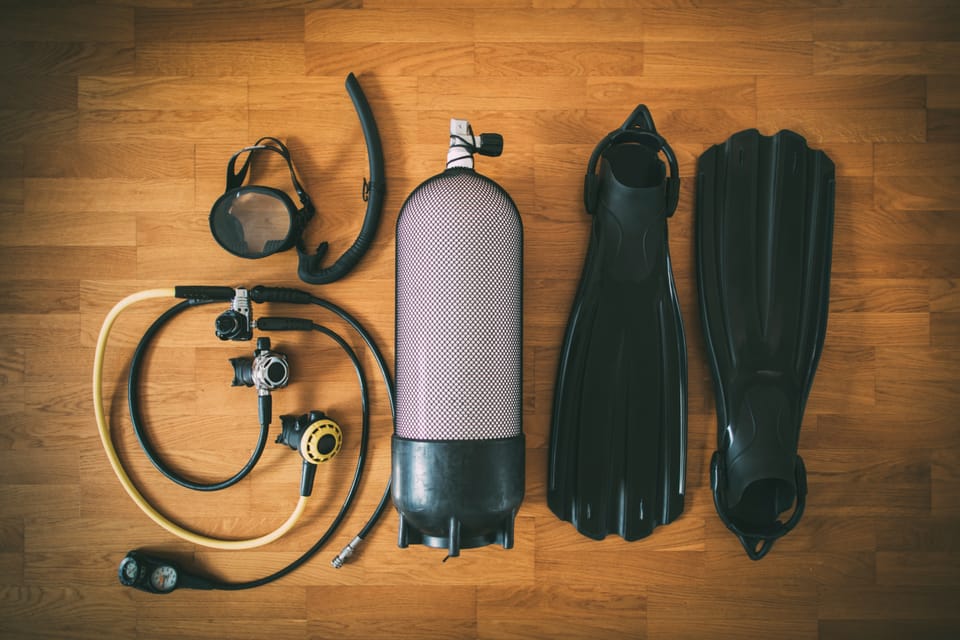
This article is aimed at both new and novice divers, as well as advanced divers who want to learn more about the equipment we use. This article aims to cover all individual pieces of equipment and give an in-depth explanation of:
- What each piece of equipment is used for
- The Different Types of each piece of equipment that exist
- How to choose the correct piece of equipment
- The Common mistakes to avoid with each one
- The Price Range
Each piece of equipment has its own "in-depth" article to go even further!
At the end of the article, I answer common questions divers have regarding gear (e.g., is it better to rent or to buy?...)
Table of Contents
- Mask
- Fins
- Diving suit
- BCD/Wing
- Regulator
- Computer
- Accessories
- Scuba gear you need as a beginner
- Buying vs Renting
- Care and Maintenance
The equipment we use as divers
Diving is a sport that relies heavily on equipment; simply put, without equipment, there is no diving. For this reason (among others), divers need to understand not only what equipment pieces exist and their use, but also how to choose the correct one. If you are planning to buy your own scuba gear, it is important that you know all there is to know about the equipment!
Some agencies group the equipment we use in "categories". The following classification is how SSI (Scuba School International) groups the diving gear:
- The snorkeling system includes all the equipment that is used for snorkeling: mask, snorkel, fins
- The Exposure system includes everything that protects you from the environment (temperature, wildlife, etc): Diving suit, boots, gloves, hood, etc...
- The Delivery system consists of the gear that will deliver the air at the correct pressure: Regulator, tank
- The Buoyancy system includes everything that you use to control your buoyancy: BCD/Wing, weights, etc... (Drysuits can also be used as buoyancy devices)
- The Information system includes everything that gives you information during the dive: Dive computer, pressure gauge, etc...
- The Accessory system is all the accessories: Torch, SMB, Wetnotes, Knife, etc...
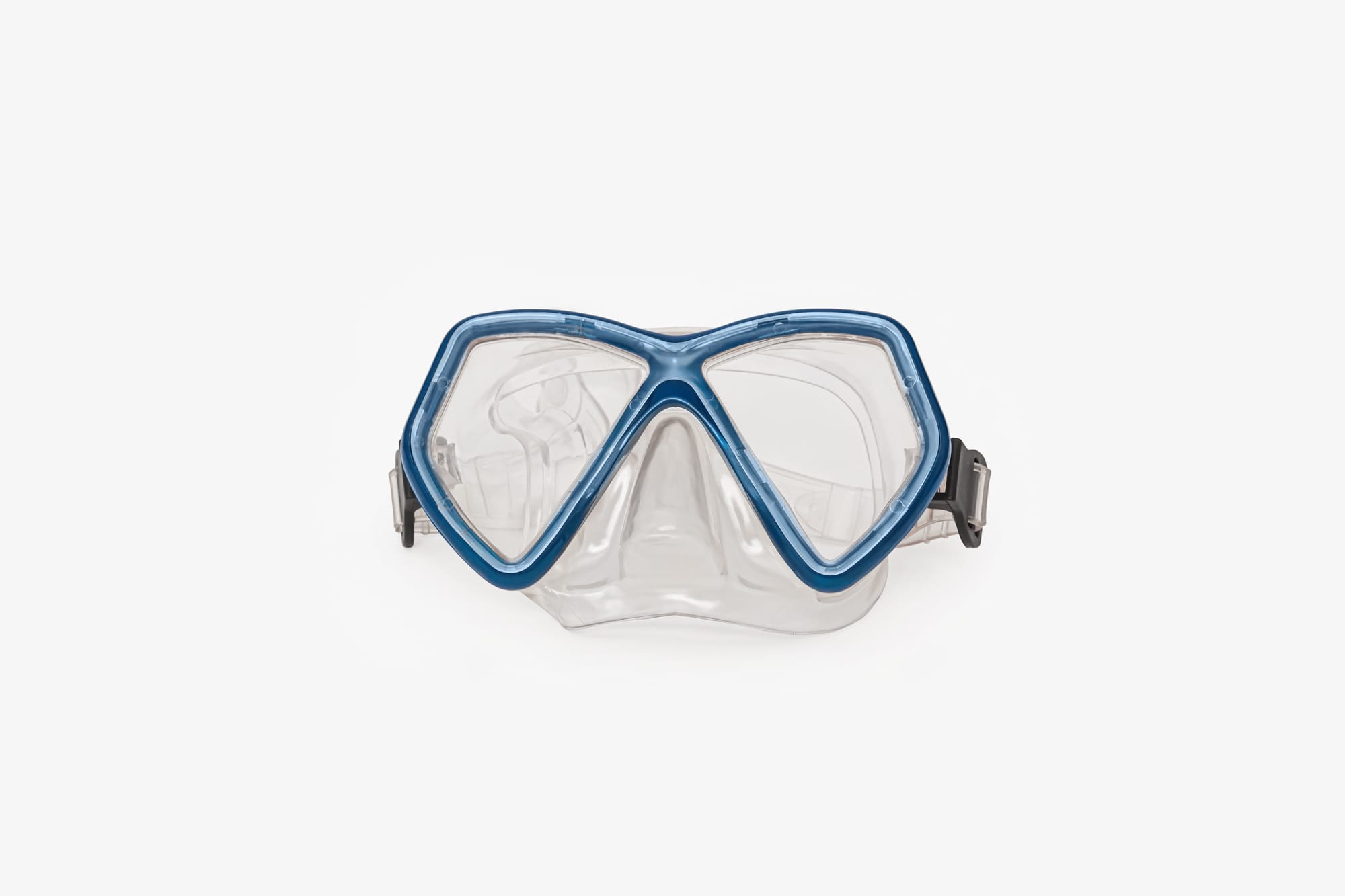
Mask
What is a mask? A mask is an integral part of your scuba equipment, as it allows you to see clearly underwater. It creates an air space between your eyes and the water, allowing your eyes to focus and see clearly all that the sea has to offer. If you opened your eyes in the water without a mask, you would still be able to see, although it would be very blurry! On top of allowing you to enjoy the underwater scenery, masks come with a flexible nose pocket, allowing you to easily equalize.
Different types of masks: There are as many types of masks as there are divers; everyone should find a mask that suits them. The first thing you will notice about masks is that they are very varied in color, meaning you can personalize them as much as you want. Another important criteria for masks is the choice between a Single Lens or a Double Lens mask: Simply put, a single lens mask will be made up of a single lens (no break in the middle), whereas a double lens mask will have a pair (two) of lenses. Usually, a mask with a single lens will give a better field of view. Some diving masks are also similar to freediving masks, offering a lower internal volume.
Choosing a mask: Once you know the type of mask you want, it's also important to make sure it fits! To make sure the mask fits properly, tilt your head slightly backwards and put the mask on your face (without attaching the strap behind your head), then have someone look around the mask to make sure there are no gaps between the seal and your skin. If that is the case, you can then inhale gently and tilt your head forward: if the mask stays on your face and doesn't fall off, it's a good sign it will fit!
Common mask mistakes to avoid: If you followed the previous paragraph and got yourself a mask that fit you, that's already the most common mistake avoided: getting yourself a mask without trying it/that doesn't fit you. Another common mistake is to not prepare the mask to prevent fogging. Common treatments include: putting toothpaste on the mask, burning the inner lens (should only be done by a professional as you risk damaging the mask), applying antifog product, etc...
Price range: Entry-level diving masks are quite affordable, starting as cheap as 40€ to high-end diving masks, which can reach 200€. A mid-range diving mask will cost around 80€. Additional prescription lenses might make the price increase a little bit.
To learn more about masks, read this article, which talks about masks in more detail.
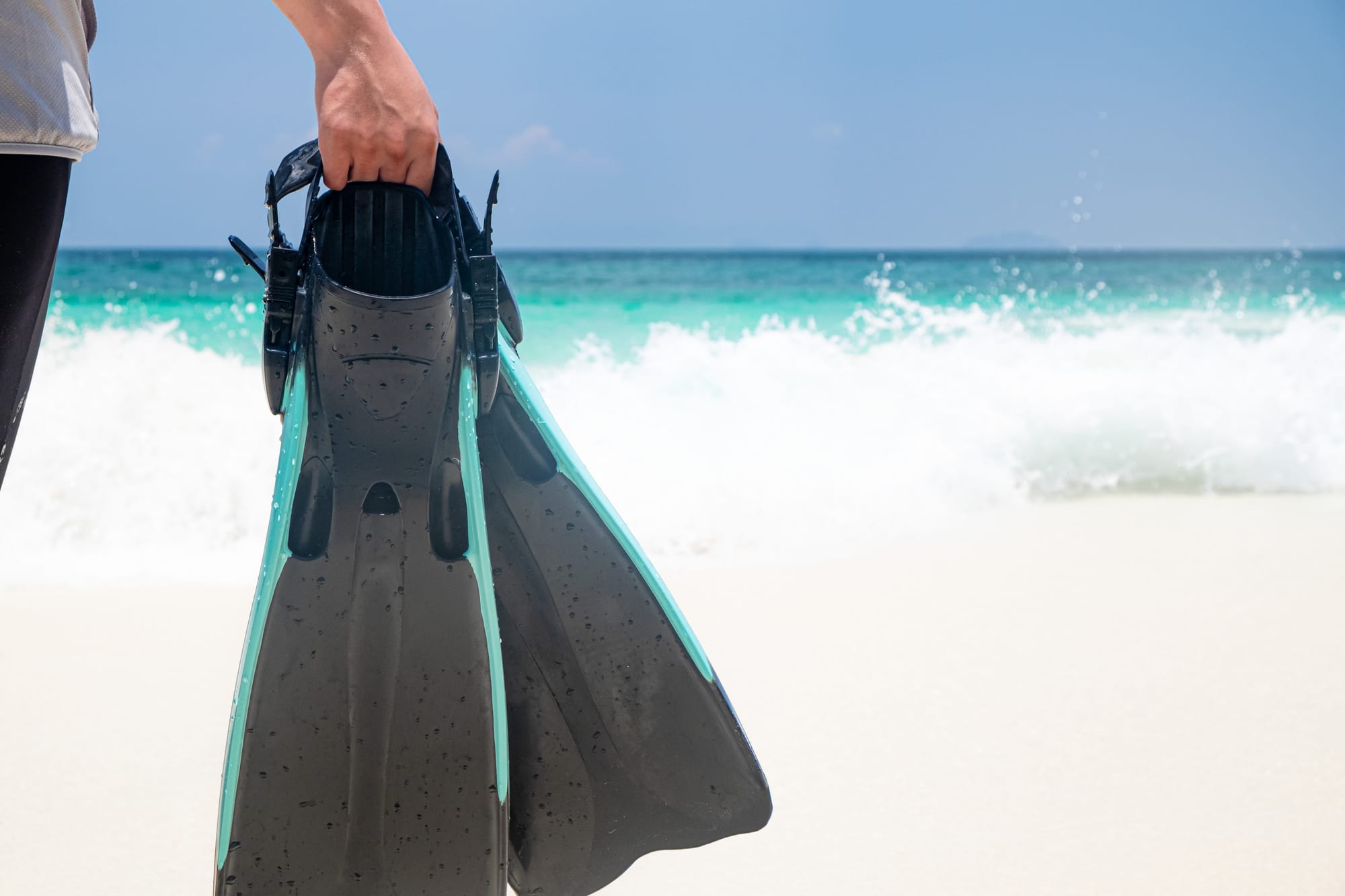
Fins
What are fins? Fins are the equipment piece that helps you move through the water. Fins increase the surface area of your foot (think of duck feet), allowing you to displace more water with each kick, and the more water you push, the more you move forward! If you've ever tried to remove your fins and kick yourself forward, you know just how hard it is with just your feet!
Different types of fins: There are many different types of fins. The first distinction we can make is between diving fins and snorkeling fins, diving fins usually being stiffer and not requiring booties underneath the fins (contrary to snorkeling fins, which are more flexible and can be worn without anything else). Freediving fins are longer, and even more efficient and powerful than diving fins (as freedivers need the maximum efficiency they can get, as they only get one breath!). For diving fins specifically, there are multiple options, such as short fins (which make it easier to be precise in environments such as wrecks), long fins, and split fins (which put less strain on your legs), heavy fins, light fins, open-heel fins, full foot fins, etc... As it is hard to describe in detail what each different kind of fin is good for in a single paragraph, check out this article, where I explain in detail what each type of fin can be used for!
Choosing fins: The fins you choose will depend on what you are going to do and where; are you going to dive, snorkel, or even freedive? In the tropics? In frozen lakes? On wrecks? If you are going to dive, good starter fins are long fins with open-heel (getting an open-heel fin means you will have to buy booties as well, but it will make your experience more comfortable). If you are an advanced diver who is looking to perfect your trim and buoyancy, we recommend shorter fins (such as the Apeks RK3/RK4 or Scubapro Jetfins), as they will help you become more stable and comfortable underwater. Some more advanced fins have a heavier/lighter version, depending on whether your legs are positively or negatively buoyant.
Common fins mistakes to avoid: The first prevalent mistake people often make is calling fins "flippers"; they are called fins, not flippers! Another common mistake to avoid when purchasing strap fins is not buying booties, as using them without booties will hurt your heel! Make sure to try on the fin with the booty on to make sure the size fits! A mistake often made by beginners is to try to "bicycle kick" when using fins, whereas divers should either flutter kick (using the hips to move the legs up and down) or frog kick (a more advanced finning technique) rather than trying to push the water away.
Price range: The price of fins is very similar to the price of masks; the cheapest snorkeling fins could be found for as low as 10-15€, while an entry-level diving fin can be found for as low as 40€. For a mid-range diving fin, you can find a good deal for 80€. The best High-end scuba diving fins (such as the Apeks RK3, Jetfins, OMS Slipstream, etc... which are very appreciated by tech divers) are priced between 150-200€. For freediving fins, although you can find cheap ones for less than 100€, the most expensive ones (with the blade usually made out of carbon fiber) can go upwards of 500€.
To learn more about fins, read this article, which is a complete scuba diving fins guide!

Diving Suit
What are diving suits? Diving suits are the main equipment piece that will keep the divers warm and protect them from exposure to the elements. As the thermal conduction of water is greater than that of air, the human body loses heat at an accelerated rate when submerged (even if the water seems warm, the body slowly loses energy over time): for this reason, it is necessary to wear a suit to prevent hypothermia. Although its principal purpose is to keep the diver warm, it can also protect them against stinging marine life, sharp edges on wrecks, etc...
Different types of diving suits: There are three main types of diving suits:
- The first type is the wetsuit, which is the most basic one. The way it works is that the flow of water entering and exiting the suit is limited, and the water that the body heats up stays in the suit and in contact with the skin (meaning the body doesn't lose energy trying to constantly heat up "new" water). Although the flow is limited, water exchange between the suit and the outer environment is still possible with the wetsuit, limiting its capabilities. Wetsuits are usually worn in warm, tropical climates.
- The second type of diving suit is the semi-dry suit: Although the idea behind the semi-dry is the same as the wetsuit, the key difference is that in a semi-dry, there are seals in the arms and the legs, and the zipper is water thight; that way, water is allowed to flow in, but is completely blocked from flowing out. This improves the suit's insulating properties and keeps the diver even warmer than a simple wetsuit. Semi-dry suits are worn in temperate climates.
- The third type is the drysuit: The drysuit isolates the diver completely from the outer environment as it doesn't even let water in! As the name suggests, a drysuit keeps the diver completely dry. However, a drysuit requires a connection to the tank to be inflated as the diver descends to prevent suit squeeze. It also requires a little bit of extra training to use properly, as it can be used as an independent buoyancy device. The drysuit is the suit of choice for divers diving in the coldest and challenging conditions! From the frozen lakes in Northern Europe to the Cenotes in Mexico!
On top of the different types of dry suits that exist, wetsuits and semi-dry suits can also have varying thicknesses (the usual thickness ranges from 3mm to 8mm). The thicker the suit, the warmer it will keep you!
Choosing a diving suit: The choice of the correct diving suit mostly depends on where you plan to dive. The primary consideration will be the water temperature: it can vary between people depending on comfort level, cold tolerance, and other criteria. There are no "general rules", but these are our recommendations: use a wetsuit in water 24°C (75°F) and above; use a semidry in water 15°C (59°F) and above; and dive in a drysuit in anything below that. Specific types of diving, such as technical diving or cave diving (both requiring a redundant buoyancy device), or public safety diving (where divers immerse themselves in contaminated water), require divers to dive in a drysuit.
Common diving suit mistakes to avoid: The most common mistake one can make with a suit is choosing the wrong one for the wrong situation or using the wrong size. The simple solution is to try it on before you rent or purchase it! Another common mistake, especially when taking thicker suits, is not taking their additional buoyancy into account when taking weights: remember that wetsuits are buoyant and require more weights to compensate. To learn more about common diving suits mistakes and issues, click on the link for the article below, which talks about everything there is to know regarding diving suits.
Price range: The price of diving suits can vary a lot depending on the type of suit you're going for. Starting with wetsuits, low-end wetsuits may be found for as low as 100€, and increase up to 500€ for thicker, better quality suits. Semi-dry suits, although slightly steeper in price, are still neighboring the price of wetsuits: They range between 300€ and 800€ depending on thickness, quality, etc... Drysuits, on the other hand, are a larger investment: the cheaper, neoprene drysuit can be bough starting around 1000€, while the more expensive, custom-sized trilaminate drysuits, range between 1500€ and 3000€ (it depends a lot on the brand!).
To learn more about diving suits, read this article, which is an in-depth guide to choosing and using a proper diving suit!
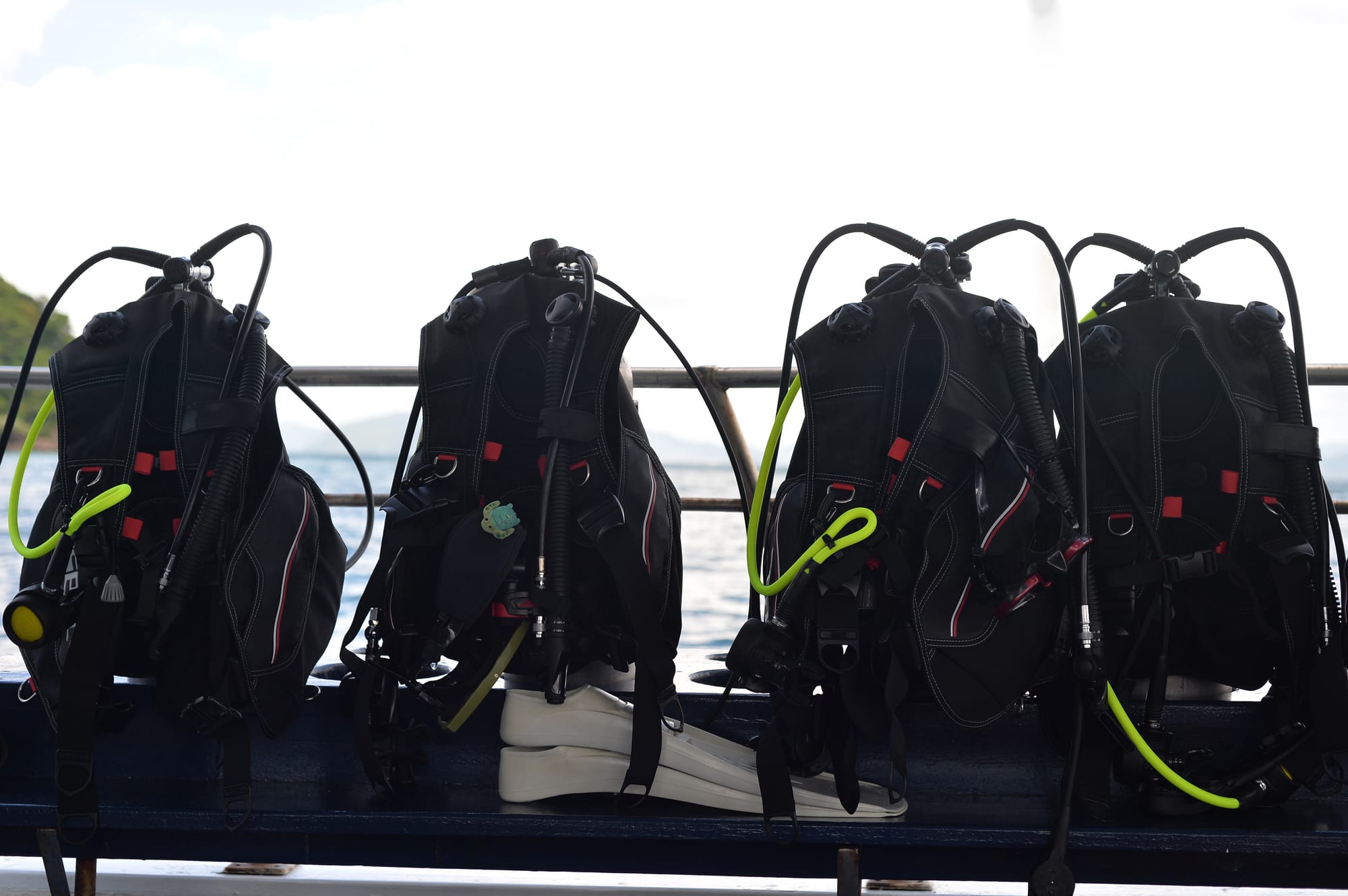
Buoyancy device (BCD or Wing)
What are BCDs? A BCD (which stands for Buoyancy Control Device, or BC for Buoyancy Compensator) is the main piece of equipment divers use to control their buoyancy. It is usually worn like a jacket (or a lifejacket!), and is attached to the tank. BCDs have an internal pouch that can be inflated or deflated using a hose connected to the tank. Simply put, if you inflate your BCD, you will increase your buoyancy; and if you deflate it, you will reduce your buoyancy. If you are on the surface, you should make sure your BCD is completely filled with air, as it will act like a lifejacket.
Different types of BCDs: There are many different kinds of Buoyancy devices that exist and are used for different purposes. The most common type of BCD is the jacket (pictured above), and as the name entails, is worn like a regular jacket. This type of BCD usually has pockets and has the air bladder integrated into its body. When inflated completely, the jacket looks like a lifejacket. A common variant of the Jacket is the Wing. The wing has distinct parts: A bladder, a backplate, and a webbing, which are all modular and can be interchanged with alternate parts. Some divers prefer it as it offers a better underwater trim and stability. There are then the other BCDs for alternate setups, such as the sidemount BCD setup (which is more intricate and requires specific training to use), the twinset BCD setup, which consists of a larger wing to lift the extra weight, and many more; If you are interested in learning about them in detail, click on the link of the article below which talks about BCDs in greater details!
Choosing a BCD: Choosing a BCD is not as complex as choosing other parts of your equipment. If you are diving in single backmount, you will need to choose between a traditional jacket, a wing, or a hybrid (yes, they exist!). Another important choice to make is the bladder volume to determine the lift capacity of the BCD: this will mainly depend on your size, weight, which equipment you use (eg. steel tanks or aluminum), and anything that might impact your buoyancy.
Common BCD mistakes to avoid: One of the most common mistakes when using a BCD is seen when diving: the underwater position needed to deflate the BCD can be tricky to master, but it is key to becoming a good diver. It is common to see divers not lifting their inflator hose completely when deflating; this prevents the air from escaping, which can lead to an uncontrolled ascent. Remember, air likes to find the highest point to escape, and therefore, you will have to lift the hose as far up as possible to release air. Another mistake that can be avoided with the BCD/Wing (as it can be with other pieces of equipment) is choosing one that doesn't fit you properly! To avoid that, make sure to try it on with the suit you're goijg to wear to make sure it fits before buying or renting.
Price range: The price of your BCD will vary greatly depending on its type, quality, etc... An entry-level jacket-style BCD might cost as low as 300€, while a specialized, high-quality wing will cost upwards of 1000€. On average, you can find good quality BCDs and wings between 400€ and 700€.
To learn more about BCDs, read this article, which is an in-depth guide to choosing and using a proper diving suit!
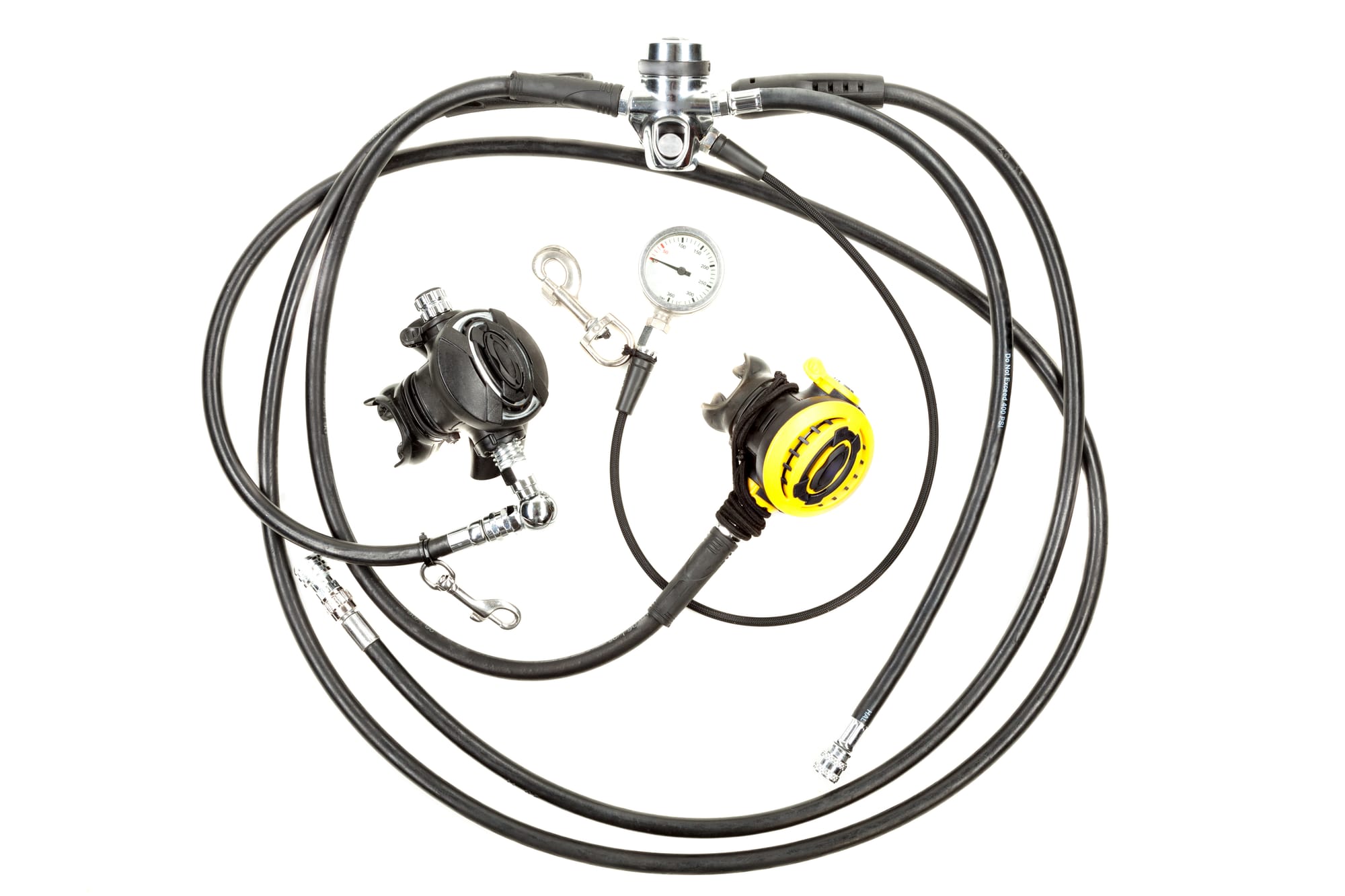
Regulator
What is a regulator? A regulator is the apparatus that allows you to breathe underwater. As the air inside your tank is under high pressure, a regulator regulates that pressure and lowers it to a breathable pressure. This means that at any depth, the pressure of the gas you inhale is the same as the ambient pressure. This "pressure reduction" happens in two parts: the first part takes place in the first stage, which is the part of the regulator that connects to the tank. The first stage reduces the high-pressure gas to an intermediate pressure (which is between 8 and 11 atm above ambient pressure depending on the model). This intermediate pressure is still too high for us to breathe directly, and therefore it undergoes a second reduction, which takes place in the second stage (which is the piece we breathe from), and reduces the so-called intermediate pressure to a breathable pressure.
Different types of regulators: as regulators evolved throughout the years, there have been different versions that have been used for various purposes. The main variants are the Yoke and DIN regulators, whose difference can be noticed in the connection mechanism to the tank. The Yoke is mainly used in the USA and other countries in Asia, while the DIN is used in Europe and for technical diving (as it is considered safer, on top of being able to handle more pressure). There are inserts/adapters that can be installed on the tank to use a yoke or DIN regulator interchangeably. There are other variants among regulators, which mainly affect the mechanism by which the regulator works. For instance, a regulator can be balanced or Unbalanced, which affects the variation of the intermediate pressure as the tank empties (an unbalanced regulator's intermediate pressure varies, whereas a balanced regulator's doesn't). There are even more types of regulators to choose from (diaphragm, or piston, for example); if you're interested in reading in detail about all the different types of regulators and how they work, click on the link below that links directly to the main page about regulators!
Choosing a regulator: The regulator you will buy will mainly depend on your activity and your primary dive location. If you dive in North America, you will most likely need a Yoke, while in the rest of the world, a DIN is strongly recommended. If you are tec diving, DIN regulators are the norm. The next criterion to take into account is the temperature of the water you will be diving in: if you are diving in cold water (lakes in Switzerland, North Sea, Scandinavian countries, etc...), you will require a regulator manufactured specifically for cold water. Those regulators are stiffer and free-flow less easily; if your regulator free-flows in cold water, you incur the risk of the first stage freezing and becoming completely unusable. Some regulator manufacturers (such as Apeks) sell regulators made specifically for cold-water diving. Other than those criteria, a lot of options for regulators come down to personal preference (such as design, colors, etc...).
Common regulator mistakes to avoid: The first mistake new divers make is not installing their regulator properly; it is important to make sure the hoses are on the correct side, streamlined, and aren't tangled. Once correctly installed and you are ready to dive, another mistake you might make is not breathing properly from the second stage: bite down gently on the mouthpiece and put your lips on the upper ridge as high as you can on the mouthpiece. Make sure your breathing is deep, slow, and relaxed. Another very common mistake divers make is when they take out the regulator from their mouth while still submerged: they often forget to exhale slightly (as to not hold your breath, which is the first rule of scuba diving), and mistakenly point their mouthpiece up to the surface (it should instead be pointing downwards to prevent free-flow). To learn about the mistakes to avoid in more detail, click on the link below to read more.
Price range: The price of a regulator varies a lot from model to model, as well as its rating (a cold/deep water regulator will naturally cost more than a non-cold and non-deep-rated reg). An entry-level, cheap regulator costs on average 400€. A mid-range regulator will cost between 600€ and 800€ on average. A high-end, specialized regulator can cost anywhere from 800€ to 1500€. It is also possible to buy spare parts for the regulator. A first stage costs on average between 200€ and 300€, while a single second stage costs on average between 100€ et 250€. If you want to buy hoses, each single hose will cost you between 25€ and 50€.
To learn more about regulators, read this article, which is your go-to guide for a full understanding of regulators!
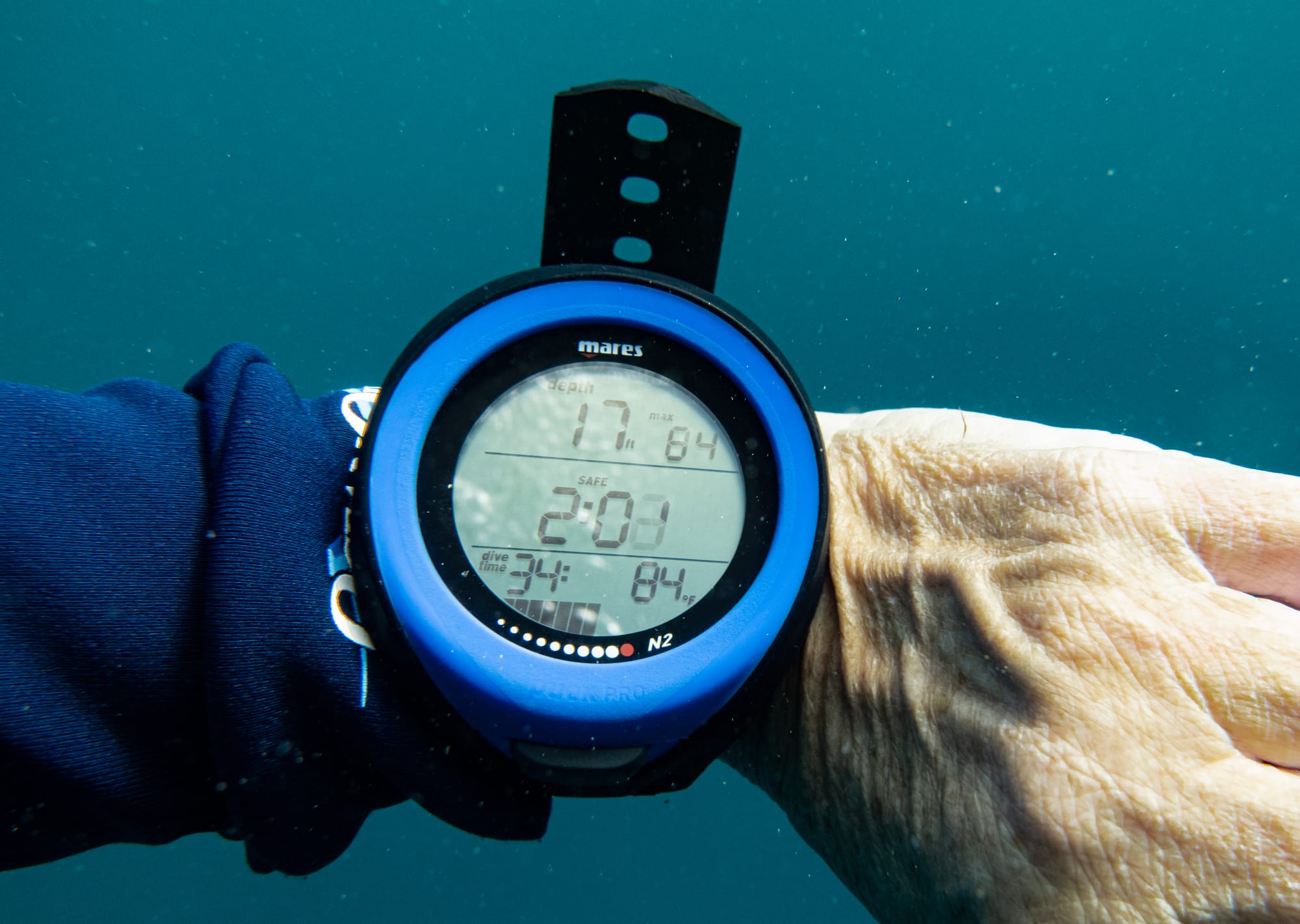
Diving Computer
What is a diving Computer? A diving computer is an instrument used to monitor certain information about the dive, such as the depth, the dive time, nitrogen saturation status, and more. For beginner divers, a computer is a great tool to monitor depth, making sure the maximum depth, dive time, and general dive plan is respected; for advanced and technical divers, a computer is a must-have tool to monitor the decompression/no-decompression status, nitrogen saturation level, and even more advanced informations such as surface gradient throughout the dive. Due to being worn on the wrist, dive computers are often wrongly called "diving watches".
Different types/modes of diving computers: Dive computers can come in different forms and can be set in different modes for various purposes. Looking at the types of computers available on the market, we can find the traditional wrist-worn computer, possibly the most common type of computer, sometimes confused with watches. Some wrist-worn dive computers (such as the Garmin computers) are sold as all-purpose fitness/lifestyle computers and can be used on the surface as well as in the water for activities such as running, cycling, etc... Some other dive computers known as computer consoles are integrated into the SPG, not requiring the diver to wear it on the wrist, although they are becoming less common. There are also dive computers that can be mounted on the mask or on the regulator (such as the Shearwater NERD 2), allowing the diver to constantly monitor their depth and dive data in real time.
Regarding the different modes that are available on a traditional dive computer, most dive computers allow the diver to switch the mix from a regular air mix to a nitrox mix, allowing an extended bottom time. Some dive computers even have a multi-gas function, used by technical divers when they perform a gas switch and change the gas they breathe during the dive. Most dive computers also have a freedive/gauge mode, used to monitor the depth and dive time without taking any nitrogen loading information into account.
Choosing a computer: Choosing a computer will come down to your budget and what you intend to use it for. If you are just starting out as a diver, we recommend getting a cheap and easy computer (such as a Suunto Zoop Novo or a Mares Puck Pro) to learn the ropes with. If you are a confirmed diver or if you intend to dive more seriously, you might choose to go for a higher-end computer with more features, such as multi-gassing (such as the Shearwater Peregrine/Perdrix or a Garmin). If you are planning on becoming a professional/technical diver, your computer will become a crucial part of your diving system, and we recommend choosing a solid computer that will last you a while, and getting familiar with all its capabilities and features.
Common computer mistakes to avoid: Most mistakes regarding dive computers relate to the diver not being attentive and not double-checking before a dive. For instance, a common issue we have seen divers encounter is starting the dive without checking that the battery works, and when descending, the computer doesn't turn on. Another example we have seen happen (and that can result in an injury, especially on deep dives) is the diver forgetting to check they have their computer set on the correct gas mix (air, nitrox, etc...) resulting in them following an innacurate plan. As a general rule, before a dive, always check that your computer works, is charged, and is has the correct settings.
Price range: The price of a dive computer can vary greatly depending on the brand, model, and capabilities. An Entry-level dive computer will cost between 200€ and 300€; however, it will be limited in its uses. If you choose to go for a mid-range dive computer with more features (such as multi-gassing, better user interface, etc...), the price will range between 300€ and 700€. Above 700€, your dive computer will have very advanced features, such as possible air integration with a transmitter, using trimix, choosing your own decompression model, etc... The most expensive dive computers can cost anywhere up to 1300€-1500€.
To learn more about dive computers, read this article, which is an in-depth guide to choosing and using your own dive computer!
Accessories
Compass: Underwater, navigation is different than on the surface due to the third dimension coming into play (depth). As GPS isn't an option, divers need a way to navigate and find their way through dive sites. A compass is a reliable way of navigating underwater, especially on dive sites without natural reference, such as murky water or dives in the blue. Diving compasses have a window and a marker for the bearing that needs to be followed that can be adjusted, allowing for specific patterns to be followed, such as reciprocal path, square paths, and more. Although most divers don't require a compass, it is necessary for dive guides/instructors to have one on them at all times.
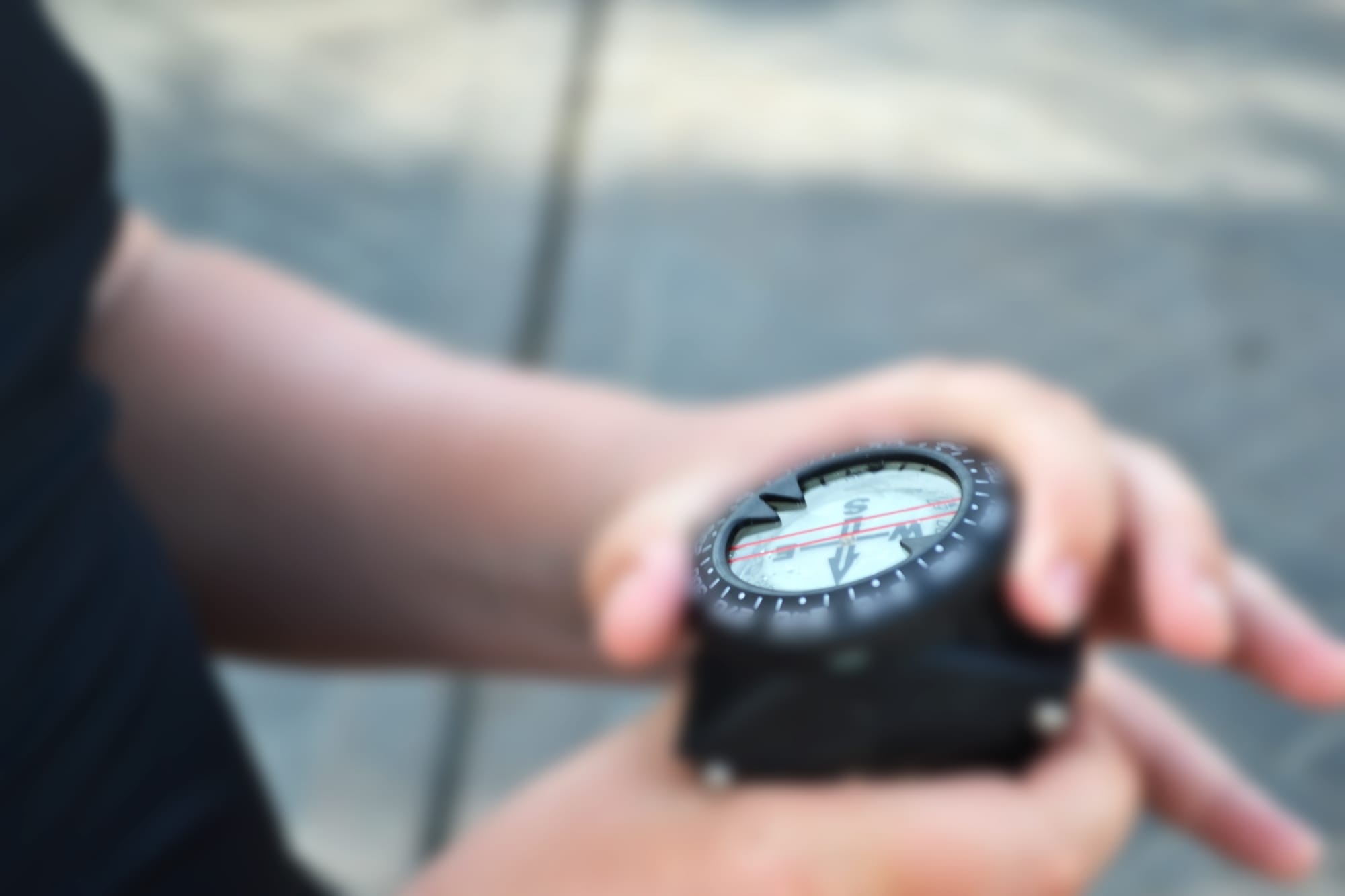
SMB/DSMB: An SMB (Surface Marker Buoy), also called a DSMB (Delayed Surface Marking Buoy) is an inflatable buoy meant to be sent by the diver from the depth to the surface for multiple purposes. The main purpose is to alert surface personnel and boats that a diver is present underwater. They are very common (and sometimes required) in countries where divers are predominantly from boats. SMBs are usually orange to be visible from a distance (as it contrasts well with the sea), but alternative colors exist as well; yellow is a common variant, used to call out an emergency, although the meaning is not common to all countries. It is strongly recommended for all divers to have at least one SMB/DSMB per team.
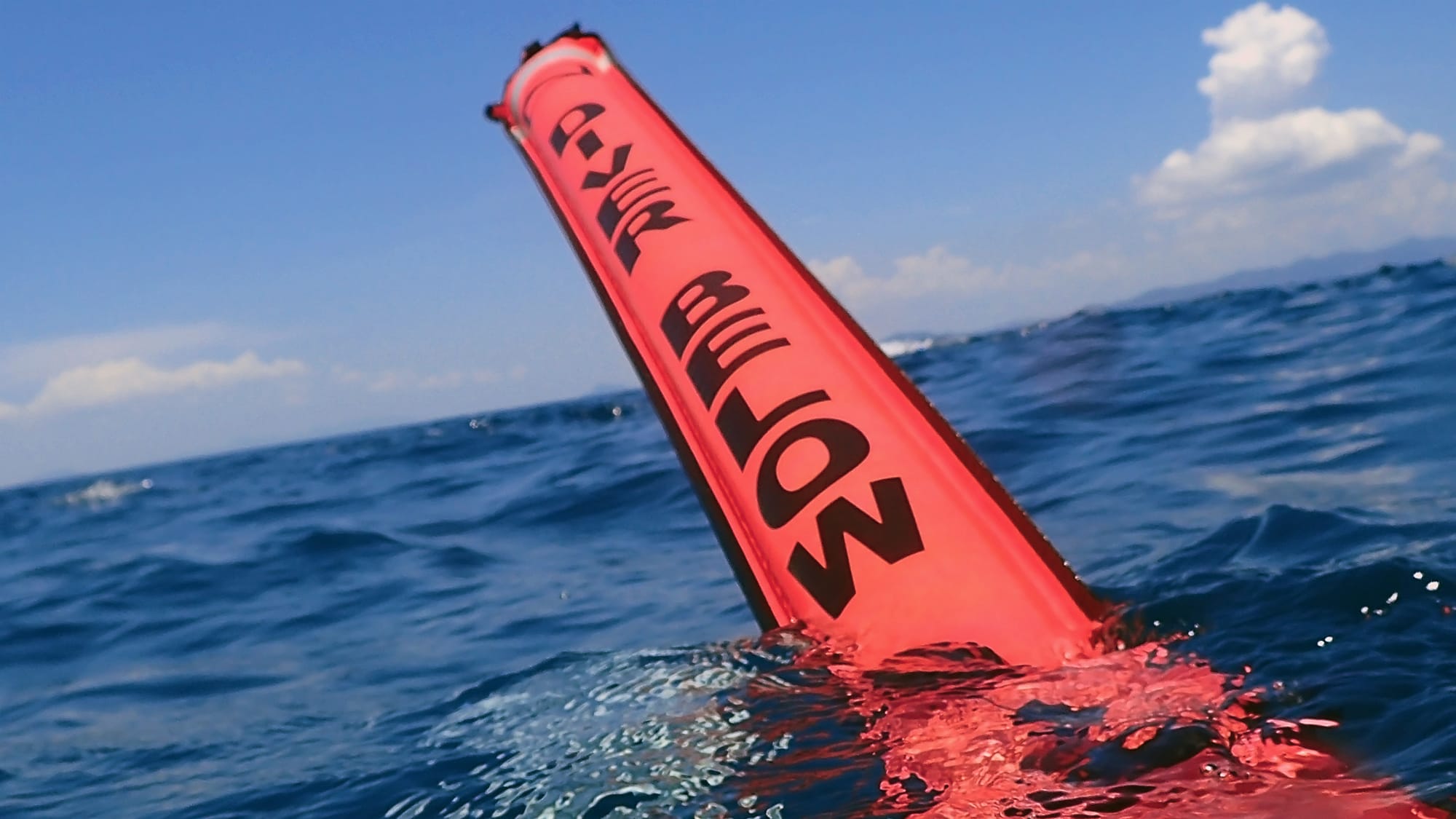
Knife/Cutting Device: A cutting device is useful for environments where tanglement might be an issue (wreck with electrical cables still present, popular fishing spot with fishing lines, etc...). In case of entanglement, it is a good practice to ask for help from your dive buddy first to avoid complications. For divers focused on ecology and involved in cleanups, a knife is a must-have to cut any ghost lines or abandoned nets. Dive guides/instructors are strongly recommended to carry a dive knife at all times to be able to assist in case one of their divers becomes entangled.
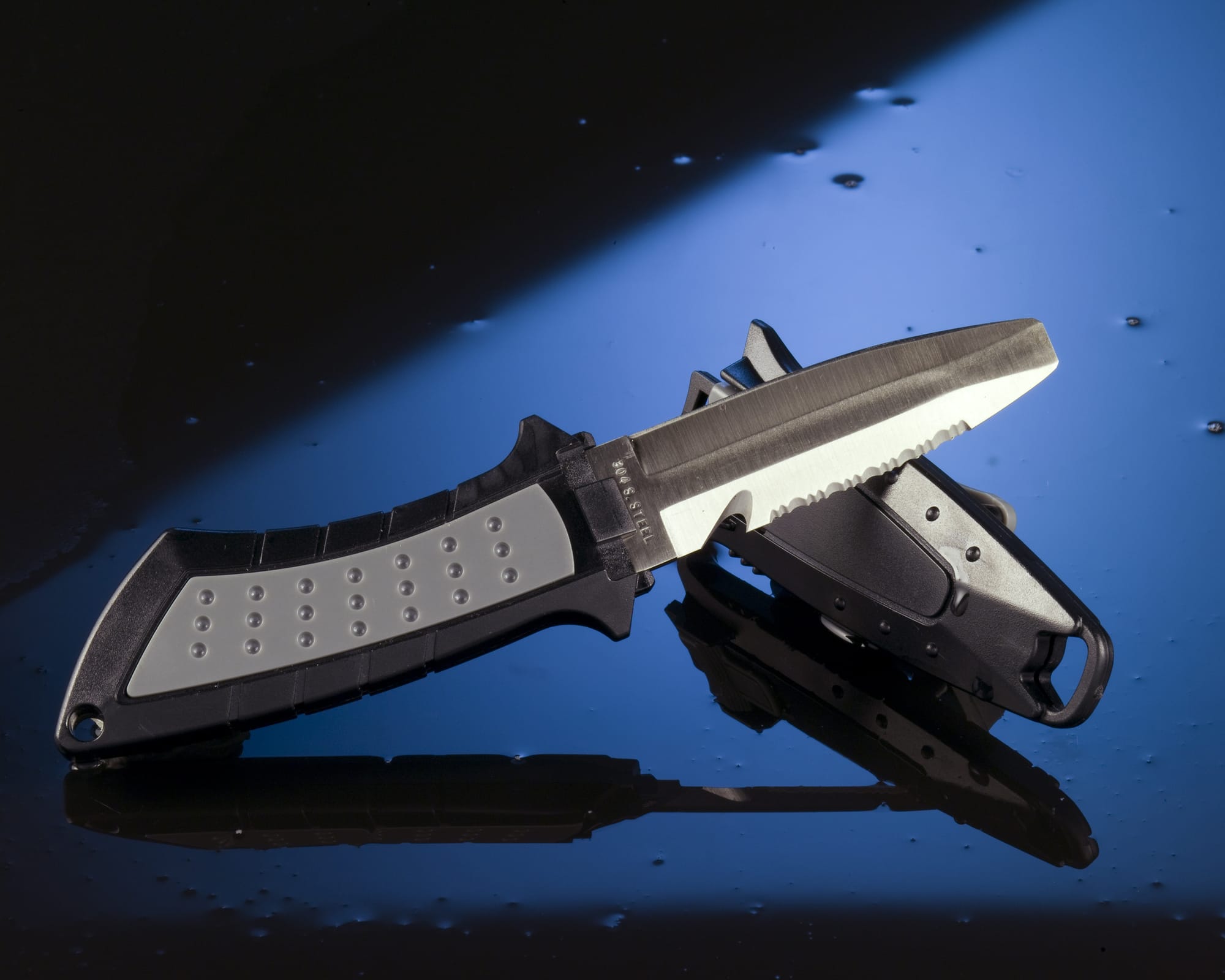
Torch: An underwater torch is used to illuminate dark areas, such as caverns or wrecks. It is also used to show the true color of the underwater scenery, as the red/purple lights that are lost relatively fast underwater can be "regained" when illuminated by white light. Dive guides/instructors use torches to point out and show elements of the fauna and flora during the dive without touching them. Dive torches shouldn't be used outside of the water as they are powerful and overheat fast when not submerged in the water.
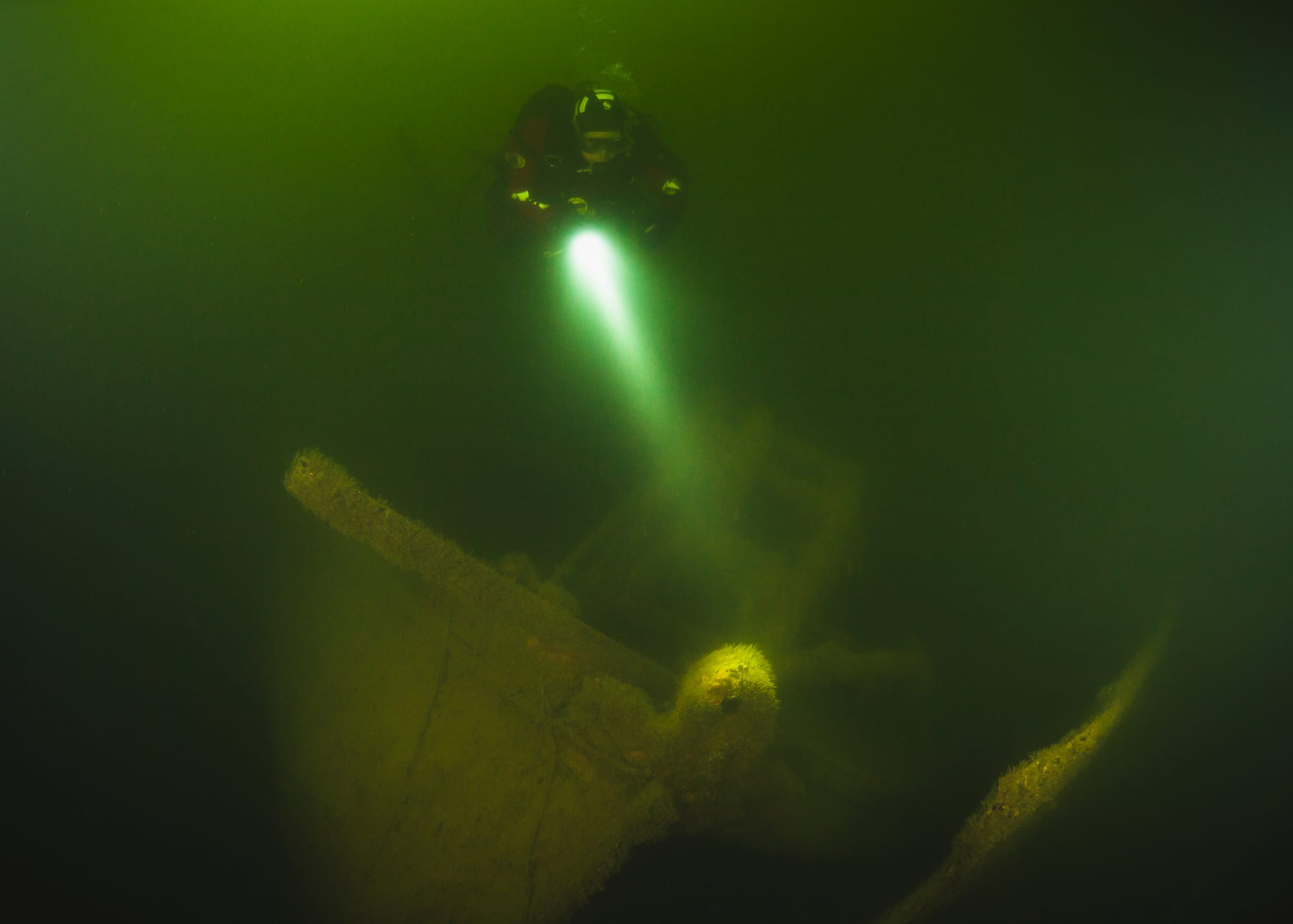
Writing Slate/Wetnotes: Wetnotes are a multipurpose tool, primarily used to communicate underwater, although they can be useful for many other purposes (underwater surveys, dive instructor grading their student, decompression plans, etc..). Wetnotes can be found as wrist slates, flat slates, or even notebooks. Instructors are required to have

Mirror: although not as common as the other accessories, mirrors still have their use; they are mainly used by dive guides to monitor divers behind them without having to completely turn. Especially useful for divers in twinset/drysuit, or any other configuration where a full turn requires more effort, mirrors will save you a lot of trouble. When diving with newer/inexperienced divers, simply using a mirror to monitor them may not be enough, as they may need to see the guide actively turning around and looking at them directly to feel safer. At shallower depths or in dive spots with prevalent light, beware of accidentally reflecting light in your buddy's eyes and temporarily blinding them!
To learn more about accessories used in scuba diving, read this article!
Scuba gear you need as a beginner
As we have detailed previously, a lot of the dive gear we recommend getting is especially useful for instructors and guides (especially looking at the accessories); However, as a beginner, we recommend getting some of the "core" equipment that will create a more positive diving experience overall
- The first piece of gear we recommend new divers get is a mask! Being able to see is such an important part of diving that it can make or break your experience. A rental mask can be great, but it can also be bad or deficient in some way: At some point in their diving career, all divers have had that one dive where they are constantly focused on making the mask fit, making sure it doesn't fog, and emptying water that flooded, instead of actually focusing on the dive. Having your own properly-fitting mask that is treated to prevent fogging regularly will enhance your dives and
- Another important piece of equipment divers must have is their own dive computer. Having a personal computer is not only desirable for aesthetic purposes, as you can choose colors and make sure it fits with the rest of your equipment, but it is also recommended as it helps track your nitrogen intake throughout multiple dives. Using a rental one, you might find yourself in the situation where you are switching from computer to computer over the course of multiple days/dives, however, even a few hours after diving (especially if deep-diving was involved), there can still be nitrogen in your tissues (known as residual nitrogen); to make sure you are able to accurately track this residual nitrogen, using the same computer for multiple dives is essential! Having your own computer solves this issue. On top of that, it is important to be familiar with the equipment you use.
- If you choose to continue buying your own gear, the next purchase you make should either be your diving suit or your BCD: Having your own diving suit makes the preparation before the dive easier as the suit will adapt to your size and make it easier for you to slip inside, while having your own BCD will allow you to learn how to master your buoyancy and trim better.
If you dive often, we strongly recommend purchasing your full scuba gear, as familiarity with the equipment that supports you in the water will make you a better and more confident diver. That being said, you don't have to buy everything at once, even for the pieces of equipment listed above; try on and rent from a few different brands and see which one fits best before purchasing!
Buying vs Renting Scuba Gear
A big debate divers have about diving equipment is whether they should buy their own gear or simply rent it whenever they go on a diving trip. The answer to this debate will vary from person to person and is influenced by multiple factors, such as how often the diver plans to dive, where they plan to dive, and at what level.
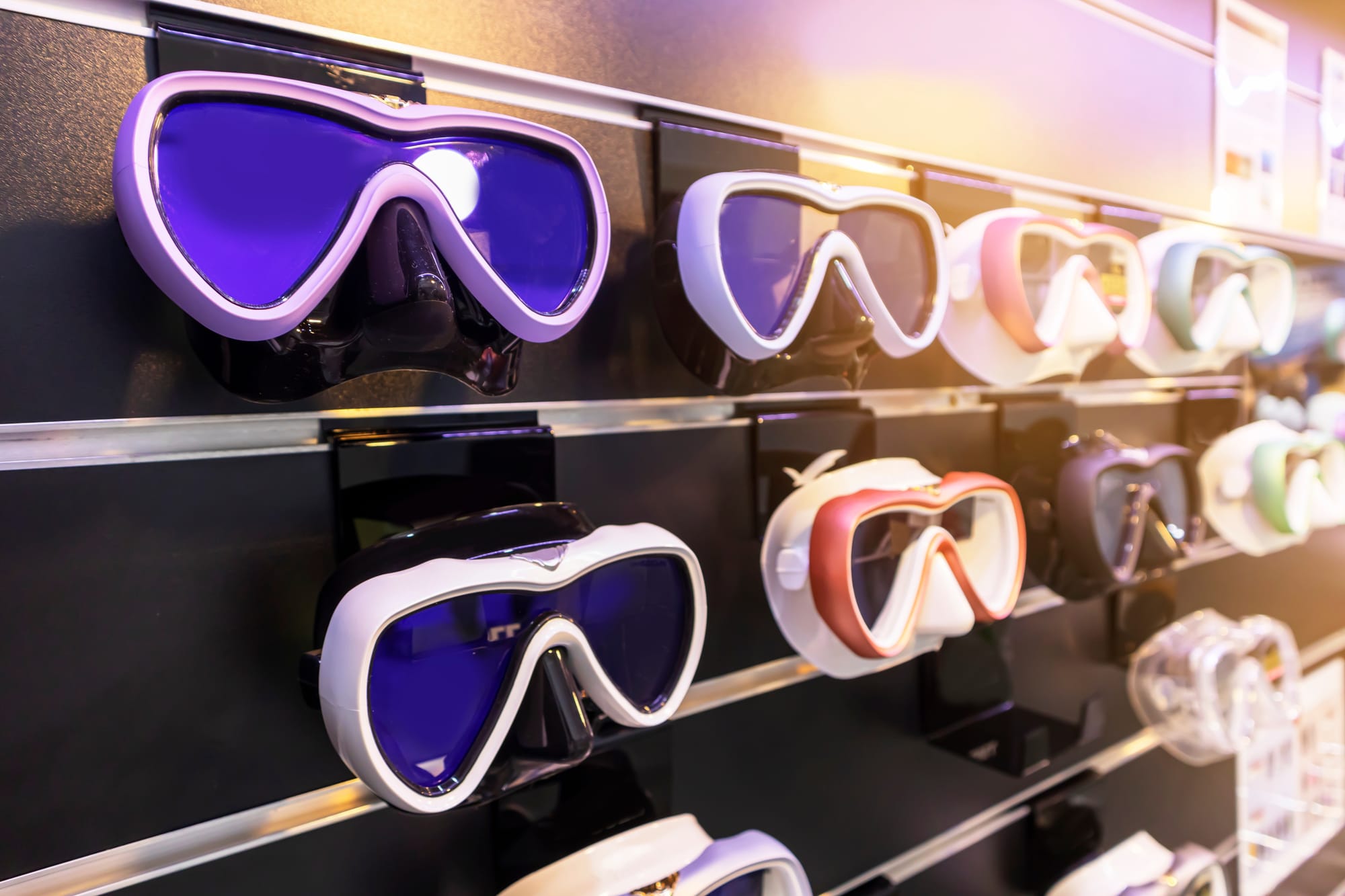
We recommend buying your own gear if: you're a dive professional (such as a guide or an instructor) or you're planning to dive at a high level (intense or technical dives), in both scenarios, you need to trust your equipment as much as you trust yourself, and therefore, having your own well-maintained equipment is crucial, and the price for buying your own equipment is worth your comfort and safety.
We recommend renting if: you are still a new diver and are not sure about the brand or the model of the piece of gear you'd like to go for, renting can be a great price-friendly option to ease you into the world of diving and give you time to make your decision before making a definitive purchase.
Let's list the pros and cons of buying and renting your scuba diving equipment:
Pros of Buying: Buying your equipment allows you to be more familiar with it, as you're constantly using the same model. For example, owning your own BCD/wing will greatly improve your trim and buoyancy because you will be more familiar with the weight/bladder distribution; similarly, owning your own fins or masks will make your underwater experience more comfortable. You can also personalize your diving style underwater and make yourself as unique as you want!
Cons of Buying: An obvious argument against buying your own equipment is the steep price associated with it. Getting your own scuba gear is an investment and can cost anywhere from a few hundred to a few thousand depending on which piece of equipment and the quality you get. On top of the initial price, because the equipment is yours, the price for maintenance is your responsibility as well, and you might have to service your regulator, computer, and BCD/wing every once in a while. Having your own equipment also adds another layer of complexity when you intend to travel, as if you have your own full diving kit, you will need a separate suitcase just for it!
Pros of Renting: If you are renting gear, the maintenance and servicing required are not your responsibility, which is something less to think about (and one less expense to take into account)! When you travel, that is one less luggage to take with you, and the difference in price for the plane ticket can make up for the price of renting out a full scuba kit for a couple of days. The price when you are renting is more affordable and isn't as steep as buying when you start out diving. Renting can also give you different perspectives on different kinds of gear types, brands, before actually buying it!
Cons of Renting: You won't always find rental gear that fits you perfectly or that is to your liking. Of course, Rental gear usually comes in many different sizes, but it will never be as "perfect" a fit as a high-quality piece of gear that you bought and tailored for yourself. On top of that, some pieces of equipment, such as computers, are best used when their users don't change (dive computers, for example, track nitrogen level in tissues, during and between dives; using a rental computer after another diver may interfere with and falsify the tracking of your own nitrogen level).
There is a lot of thought that must go into buying your own gear, and if you want to read more about choosing between buying and renting your scuba diving equipment, including comparing prices and expenses for both options, read this article.
Taking care of and maintaining your diving equipment
Diving is an activity that heavily relies on equipment, and as such, it is important to take care of it.
If you are renting equipment, it is always nice to know that the equipment you're using is well-maintained and taken care of. As much as it is the responsibility of the center you're renting it from to ensure they have well-maintained equipment to rent out, it is also your responsibility to take care of it during and after the dive (some dive centers will wash the equipment for you after a dive, but it isn't always the case everywhere). For example, you wouldn't like using a regulator that a previous user would have mistreated and possibly damaged, so treat it and return it the same way you would like to find it.
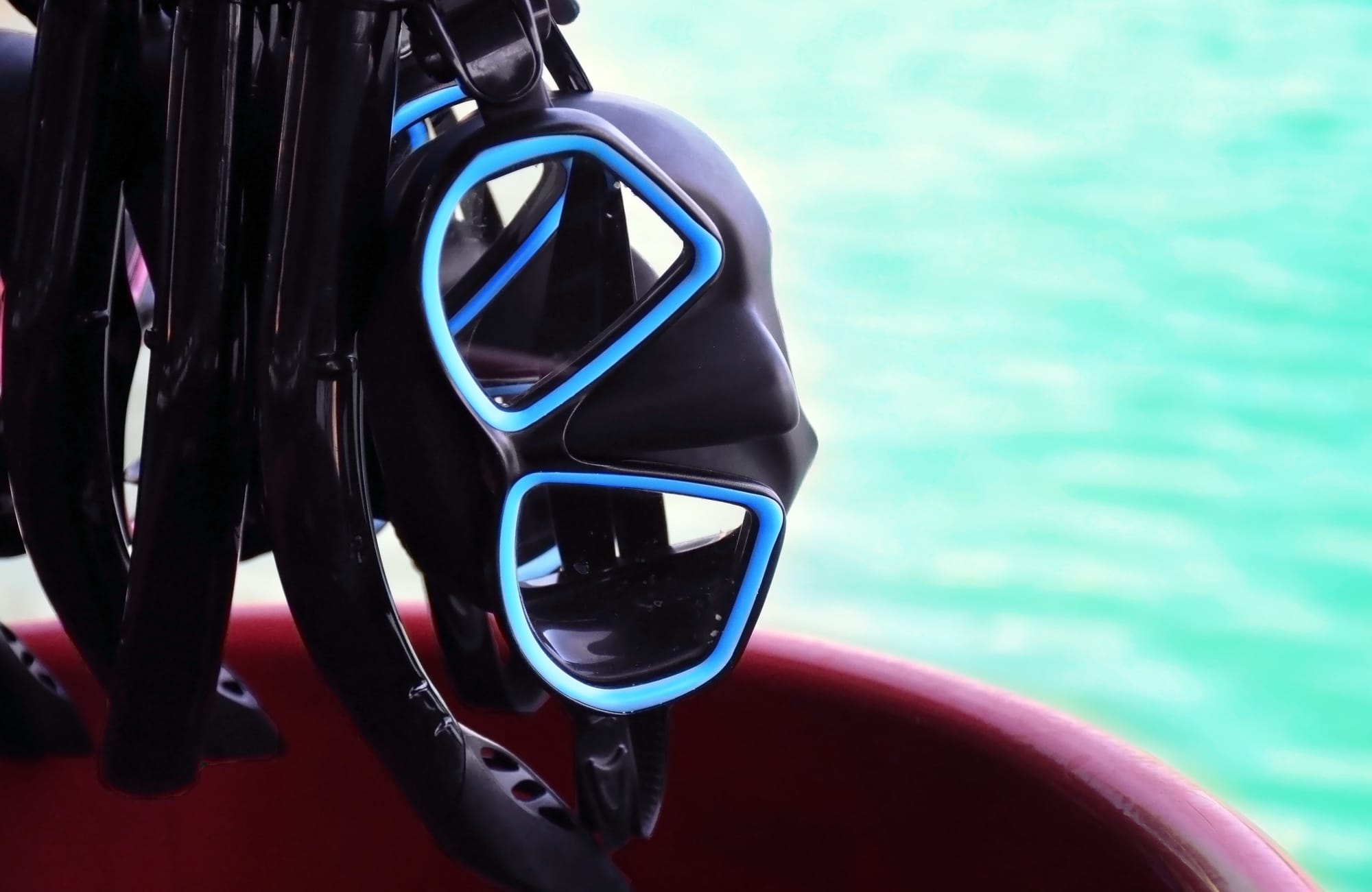
If you are using your own gear, taking care of it and maintaining it is just as important: buying diving gear can be a big expense. Regular maintenance of the gear can extend its lifespan by multiple years, ensuring you get your money's worth. On top of that, having well-maintained gear can be a question of safety: the equipment that supports you underwater should work properly!
Maintaining and taking care of your gear can be done before, during, and after the dive, as well as during periodical (yearly, bi-yearly, etc...) servicing. Let's have a general outlook on each one of those:
Before the dive, make a visual check of your equipment, ensuring that there is no damage present anywhere, check your regulator's O-ring (or the tank's O-ring if you are using a yoke regulator), and that your computer has enough battery for the dive. If you leave your equipment unattended, don't leave your tank standing up, and keep everything together to prevent anyone from accidentally walking on it. If you have any particularly fragile piece of equipment (such as the mask), a trick is to put it in the fin's foot pocket for protection.
After the dive, all the equipment you used should be rinsed with freshwater (while being careful not to put any water in the regulator's first stage) and dried before being stored in a cool and dry place. Ensure any places that are susceptible to holding water are empty (such as the bladder of your BCD), as the water, if left inside, will stagnate and form mold inside your equipment. Store in such a way as not to put strain on the equipment: for example, fins shouldn't be stored upright, standing on their blade.
As mentioned previously, some equipment needs periodical servicing. The exact frequency depends on the equipment and what the manufacturer recommends (read the manufacturer's manual for more information about that), but for example, a general rule for regulators is to get them serviced every year or every 100 dives, whichever comes first. A servicing is an in-depth process where any O-rings or brittle/used pieces in the equipment are changed for new ones. The equipment that needs servicing is the ones with O-rings, any electronics inside them, or mechanical pieces: for instance, regulators, computers, and drysuits all need servicing. It should only be done by a certified technician for each specific brand of equipment (as different brands may have different methods of servicing).
If you are interested in equipment maintenance, read this article, which is a full and in-depth guide about taking care of dive equipment.
FAQ
Q: Which equipment do I need as a beginner?
A: As a beginner, we recommend having your own mask and your own dive computer. Having a properly fitted and maintained mask will considerably improve your dive experience, while having and using your own dive computer will increase safety during the dives, as it will accurately track your nitrogen level. Although having your full dive equipment is important, especially for confirmed divers, as a beginner, the prices can be rather steep, and starting with the necessary equipment is a common thing to do.
Q: Should I rent or buy my scuba gear?
A: It will depend on what level you're planning to dive at, where you're going to dive, and the kind of dives you are planning on doing. As a general rule, when you start diving, we recommend renting each piece of equipment and trying out as many different brands as possible before making a purchase to be able to make an informed decision. Once you are sure about wanting a specific piece of equipment, buy it and take good care of it so it lasts you as long as possible.
Q: What is the difference between snorkeling and diving gear?
A: Snorkeling gear comprises a mask, a snorkel, and fins. Diving gear includes these pieces of equipment, but also has additional ones: BCDs, regulators, etc... which aren't snorkeling gear. We can say that snorkeling gear and diving gear overlap to a certain extent, but not all diving gear also includes additional pieces of equipment.
Q: Can I travel with scuba diving equipment on a plane?
A: Diving equipment is allowed on planes, although some items (such as diving knives) may be subjected to additional restrictions. Some airlines have specifically reduced prices for extra luggages carrying dive equipment!
